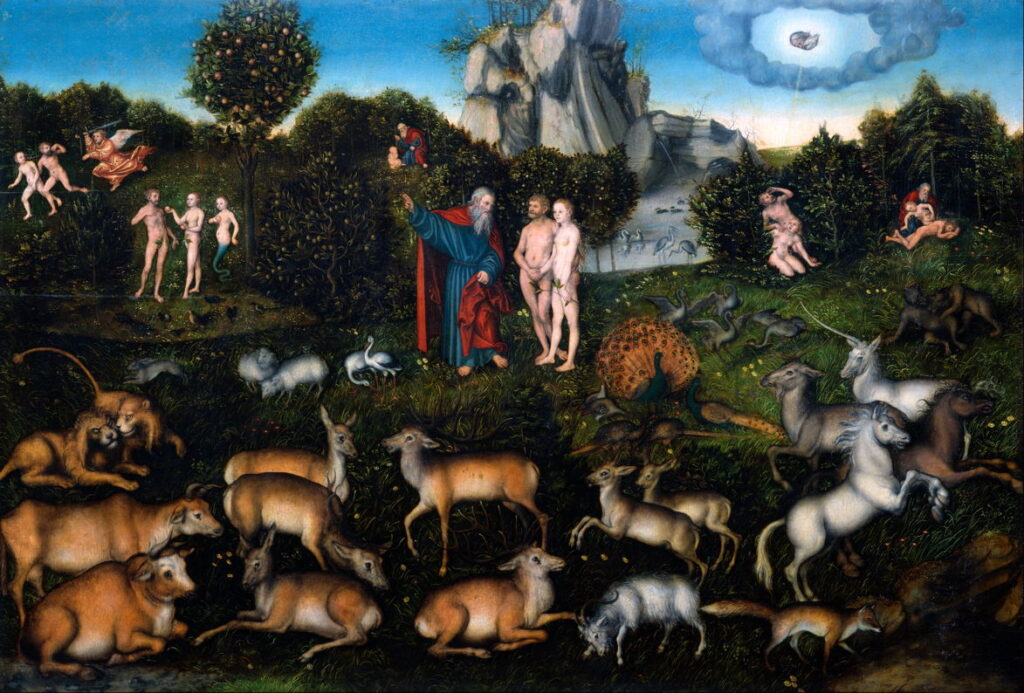Reading Visual Art: 212 Narrative modes B

I have divided narrative forms in painting into the following categories:
instantaneous, where the image is intended to show what was happening at a single moment in time, even though it’s likely to contain references to other moments in time;
multi-image, where a series of separate images (paintings) is used to tell the story;
multiplex, where a single image contains representations of two or more moments in time from a story;
multi-frame, where two or more picture frames are used to tell a story, as in comics or manga;
polymythic, where a single image contains two or more distinct stories.
The previous article showed examples of each apart from multiplex narrative, the subject of this sequel.
Multiplex
In more recent years, multiplex narrative has become considered by many narrative painters as being too complex for modern viewers. Given its popularity in ancient times and during the Renaissance, this appears curious.
Unknown, Perseus and Andromeda (soon after 11 BCE), from Boscotrecase, Italy, moved to The Metropolitan Museum of Art, New York, NY. By Yann Forget, via Wikimedia Commons.
Immediately on looking at this Roman painting of Perseus and Andromeda, you can see the duplicated images of Perseus: one flying in from the left, the other being congratulated at the right. If intended to be a literal telling of the story, Cetus the sea monster wouldn’t appear until after Perseus had freed Andromeda from her chains. It therefore contains at least two different moments in time, but isn’t divided into frames, and is therefore multiplex narrative.
Masaccio (1401–1428), The Tribute Money (1425-8), fresco, 247 x 597 cm, Brancacci Chapel, Florence. Wikimedia Commons.
Masaccio’s fresco in the Brancacci Chapel of The Tribute Money (1425-8) contains three images of Saint Peter, and two of the tax gatherer, carefully set and projected into the same single view. Although each is spaced apart from the next, no pictorial device is used to separate them into frames.
His literary reference is to the Gospel of Matthew, in a story in which Christ directs Peter to find a coin in the mouth of a fish so that he can pay the temple tax. In the centre, the tax collector asks Christ for the temple tax. At the far left, as indicated by Christ and Peter’s arms, Peter (shown a second time) takes the coin out of the mouth of a fish. At the right, Peter (a third time) pays the tax collector (shown a second time) his due.
Masaccio demonstrates how important space and layout are in successful multiplex narrative.
Piero di Cosimo (1462–1521), Andromeda freed by Perseus (c 1510-15), oil on panel, 70 x 123 cm, Galleria degli Uffizi, Florence. Wikimedia Commons.
In Piero di Cosimo’s Andromeda freed by Perseus (c 1510-15), Perseus appears three times: flying down from the top, stood on Cetus about to kill the monster, and in the subsequent party at the bottom right. Andromeda also appears at least twice. These separate events are combined in its multiplex narrative.
Lucas Cranach the Elder (1472-1553), The Garden of Eden (1530), oil on lime, 80 x 118 cm, Gemäldegalerie Alte Meister, Dresden. Wikimedia Commons.
The five different sets of Adam and Eve shown in Lucas Cranach the Elder’s The Garden of Eden (1530) are set within the representation of the garden as a whole, making this multiplex narrative.
Following the Renaissance, multiplex narrative was largely forgotten, until its more recent revival.
Jean-Baptiste-Camille Corot (1796–1875), Diana and Actaeon (1836), oil on canvas, 156.5 × 112.7 cm, The Metropolitan Museum of Art, New York, NY. Wikimedia Commons.
At the centre of Camille Corot’s painting, Diana and her attendant nymphs are bathing in a stream, and soaking up the sunshine. At the right, Actaeon with one of his hunting dogs is just about to run straight into them. Diana, appropriately crowned, stands pointing to the distant figure at the left, which is again Actaeon, antlers growing from his head as she transforms him into a stag.
Actaeon appears twice in spatially separate scenes, with Diana and her group being part of both. In the first, they are simply bathing and larking about, but in the second Diana stands, points, and transforms Actaeon.
Lovis Corinth (1858–1925), Ariadne on Naxos (1913), oil on canvas, 116 × 147 cm, Private collection. Wikimedia Commons.
In the early twentieth century, Lovis Corinth’s Ariadne on Naxos (1913) combines two separate events into a single image: the abandonment of Ariadne by Theseus on the left, and the arrival of Dionysus/Bacchus to be her future husband on the right. He does this without any duplication of actors, and it’s multiplex narrative.
Thomas Hart Benton (1889–1975), Achelous and Hercules (1947), tempera and oil on canvas mounted on plywood, 159.7 × 671 cm, Smithsonian American Art Museum, Washington, DC. Wikimedia Commons.
At the centre of Thomas Hart Benton’s Achelous and Hercules from 1947 is Hercules, stripped to the waist and wearing denim jeans, who is about to grasp the horns of Achelous, shown in the form of a bull. Immediately to the right, Deianira is shown in contemporary American form, with a young woman next to her bearing a laurel crown and seated on the Horn of Plenty. To the left of centre, Benton shows a second figure of Hercules holding a rope, part of a passage referring to ranching and cowboys, and further to the left to the grain harvest. To the right, the Horn of Plenty links into the cultivation of maize (corn), the other major crop from the area.
This narrative technique is by no means confined to Europe, as shown in the next two examples.
Unknown, Krishna Storms the Citadel of Narakasura (detail) (S India, Mysore workshop, c 1840), double page from the manuscript of the Bhagavata Purana, opaque watercolour and gold on paper, 25 x 36.84 cm (spread), Sand Diego Museum of Art, San Diego, CA. Wikimedia Commons.
This detail of Krishna Storms the Citadel of Narakasura (c 1840) contains two near-identical representations of Krishna, making it multiplex narrative.
Unknown, Heiji Monogatari Emaki (Sanjo Scroll) (平治物語絵巻 (三条殿焼討)) (Night Attack on the Sanjō Palace) (Kamakura, late 1200s), colour and ink on paper, 41.3 x 699.7 cm, Museum of Fine Arts, Boston, MA. Wikimedia Commons.
My final example of multiplex narrative is that of the Heiji Monogatari Emaki (Sanjo Scroll) (late 1200s), in which time advances from right to left, and there is duplication of actors.




